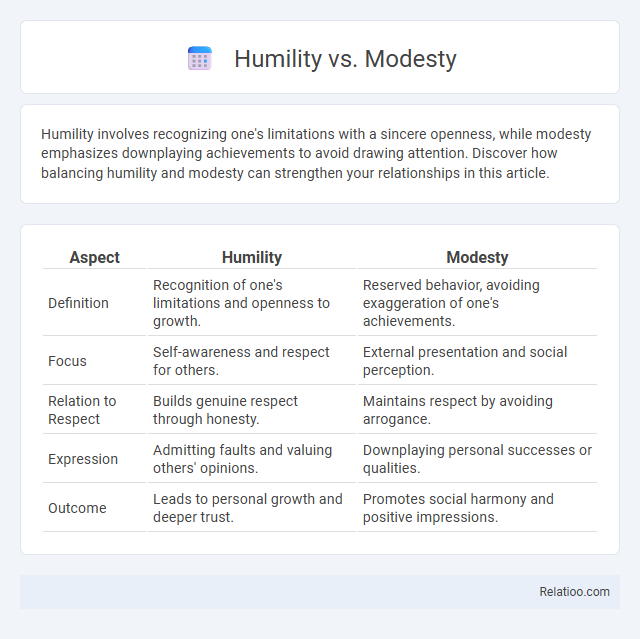Humility involves recognizing one's limitations with a sincere openness, while modesty emphasizes downplaying achievements to avoid drawing attention. Discover how balancing humility and modesty can strengthen your relationships in this article.
Table of Comparison
| Aspect | Humility | Modesty |
|---|---|---|
| Definition | Recognition of one's limitations and openness to growth. | Reserved behavior, avoiding exaggeration of one's achievements. |
| Focus | Self-awareness and respect for others. | External presentation and social perception. |
| Relation to Respect | Builds genuine respect through honesty. | Maintains respect by avoiding arrogance. |
| Expression | Admitting faults and valuing others' opinions. | Downplaying personal successes or qualities. |
| Outcome | Leads to personal growth and deeper trust. | Promotes social harmony and positive impressions. |
Defining Humility and Modesty
Humility is the quality of having a realistic view of your strengths and limitations, embracing a modest sense of self without arrogance, while modesty specifically refers to the behavior and presentation that avoids boastfulness or excess. Humility involves inner attitudes of openness and self-awareness, whereas modesty is more about outward expressions and social conduct. Understanding the distinction helps you cultivate genuine humility that goes beyond mere modesty.
Key Differences Between Humility and Modesty
Humility involves an accurate self-assessment that recognizes one's limitations and strengths without arrogance, emphasizing inner character and self-awareness. Modesty primarily relates to outward behavior and appearance, focusing on avoiding excessive pride or attention, often influenced by cultural or social norms. The key difference lies in humility being an internal virtue reflecting true self-understanding, whereas modesty is an external expression shaping how one presents oneself to others.
Historical Perspectives on Humility and Modesty
Historical perspectives on humility emphasize its role as a virtue linked to self-awareness and spiritual growth, often highlighted in religious texts like the Bible and teachings of philosophers such as St. Augustine. Modesty, historically associated with social norms and cultural expectations, has been regarded as a behavioral standard governing appearance and conduct, especially in contexts of gender and class. The nuanced distinction between humility as an inward state and modesty as outward presentation reflects evolving societal values across eras and civilizations.
Cultural Interpretations of Humility vs Modesty
Humility and modesty are often culturally interpreted through distinct lenses, where humility emphasizes an accurate self-assessment without arrogance, while modesty relates to downplaying one's achievements or appearance to conform to social norms. In many Eastern cultures, humility is deeply rooted in collective harmony and spiritual growth, whereas modesty aligns with societal expectations of behavior and dress, particularly in gender roles. Western cultures may view humility as a personal virtue reflecting inner strength, while modesty is frequently tied to etiquette and social perception.
Psychological Benefits of Being Humble
Humility involves recognizing your limitations and valuing others without seeking attention, while modesty refers to a reserved presentation of one's abilities or achievements. Embracing humility enhances psychological well-being by fostering emotional resilience, reducing stress, and promoting healthier interpersonal relationships. Your ability to practice humility supports greater self-awareness and empathy, contributing to overall mental health and social harmony.
The Social Impact of Practicing Modesty
Practicing modesty fosters positive social interactions by promoting respect, reducing envy, and encouraging genuine connections within communities. Your modest behavior can enhance group harmony and trust, creating an environment where individuals feel valued without the need for self-promotion or arrogance. Unlike humility or humility, modesty specifically emphasizes restraint in expressing one's achievements, which helps maintain social balance and mutual appreciation.
Common Misconceptions About Humility and Modesty
Humility is often misunderstood as self-deprecation, while modesty is mistaken for merely dressing or behaving conservatively; however, humility involves a genuine acknowledgment of one's limitations without arrogance, and modesty reflects respect and restraint in presenting oneself. Common misconceptions confuse humility with weakness or low self-esteem, when in reality, it demonstrates strength through self-awareness and openness to growth. Your understanding of these traits enhances authentic interactions and personal development by distinguishing true humility from false modesty or excessive self-effacement.
Humility in Leadership and Personal Growth
Humility in leadership fosters an environment where leaders acknowledge their limitations and value team contributions, enhancing trust and collaboration. Unlike modesty, which pertains to downplaying one's achievements, humility emphasizes self-awareness and the continuous pursuit of personal growth. Embracing humility enables leaders to adapt, learn from mistakes, and inspire authentic connections within their organizations.
Modesty in Communication and Behavior
Modesty in communication and behavior reflects a balanced expression of one's abilities without exaggeration, promoting respect and openness in social interactions. Unlike humility, which emphasizes a low view of oneself, modesty maintains confidence while avoiding arrogance or boastfulness. This approach fosters trust and cooperation, crucial for effective teamwork and leadership.
Balancing Humility and Modesty in Everyday Life
Balancing humility and modesty in everyday life involves recognizing your strengths without arrogance while maintaining a respectful and unpretentious attitude. Your ability to embrace humility allows you to learn and grow from experiences, whereas modesty helps you communicate achievements without seeking excessive attention. Striking this balance enhances personal relationships and fosters a grounded, authentic presence in social and professional settings.

Infographic: Humility vs Modesty
 relatioo.com
relatioo.com